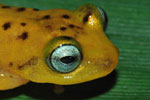
Red mangroves of Uttar Kannada. Photo by: Viraj Singh.
In the Uttar Kannada district of the Western Ghats, the livelihood of the average individual depends largely on the well being of the environment. Six months ago, before large-scale mangrove planting of the area, if someone were to walk through the banks of the mangroves in the Western Ghats he would see many fishermen casting their long nets and wires, time and time again noticing pieces of trash such as plastic grocery bags tangled in the nets.
Problems like plastic bags in the Western Ghats require simple solutions. The Snehakunj Trust that monitors one of the eight districts of the Western Ghats, deemed a UNESCO world heritage site, generates small-scale rural development activities such as the eradication of plastic grocery bags and plastic water bottles. Now as I walk the banks of the red mangroves, I see fishermen casting nets and wires, retrieving white fish from the roots of the mangroves.
Another small-scale rural development activity put in place by Snehakunj is composting. As an American, composting in a small bin in my backyard serves the simple purpose of fertilizing my vegetable garden. Yet in the Western Ghats livelihoods are built on the making and selling of compost due to the escalating cost of chemical fertilizer and a local economy based on agriculture. The immense amount of flora in the region and humid weather facilitate the composting process, yielding large amounts of usable compost throughout the year. In the Uttar Kannada district, villagers have adopted the bokashi composting method, in which the plant matter is fermented before entering the compost pit in order to reduce odor and speed up the composting process. In order to reduce fertilizer runoff and pollution that causes dead zones in the Sharavati River, the major source of water in Uttar Kannada, Snehakunj has taken an entire village under its wing, introducing organic farming and vermicomposting. Compost is a tool used to prevent soil degradation from monoculture. Soil degradation would be devastating for farmers and the agricultural economy of Uttar Kannada.
 Developing pepper pods in Snehakunj Farm. Photo by Viraj Singh. |
In India, the cremation of bodies that are then thrown into the rivers for religious purposes results in large-scale pollution in rivers. In many cases, bodies aren’t fully cremated, resulting in the contamination of water. Eighty percent of India’s deaths that result from disease are water borne, and in the rural areas of Uttar Kannada, people bathe in the same rivers that they put the cremated bodies in.
Another major source of environmental degradation is the illegal mining of iron ore in areas around Uttar Kannada. The result of this undocumented mining is iron ore so low in quality that India doesn’t use it. Instead, the iron ore is shipped to Korea and China. Three check points in Uttar Kannada have been set up to prevent the transport of the ore. The large trucks that carry the ore usually are overloaded with one and a half time the allowed cargo. Iron ore, usually made up of iron oxide, is found relatively close to the surface in large beds. To reach the ore a large hole is dug, often kilometers wide, resulting in the displacement of huge amounts of soil and deforestation. Large-scale mining projects decrease the amount of land used for agriculture and provide only temporary employment for the locals. Also farmers are reluctant to farm on old mining grounds because mining for a certain mineral such as iron depletes the amounts of nutrients in the soil needed to sustain vegetation. Iron is a key component in chlorophyll; without it plants lack the ability to photosynthesize.
The Snehakunj Trust creates more stable jobs through its 11 ½ acre organic farm which grows spices such as black pepper, cacao, and turmeric, coconuts, and other medicinal plants. The trust also sells their medicinal plants at a local dispensary qnd uses their plants at their local Ayurvedic hospital. However, even privately owned organic farms, such as the organic farm looked over by the trust, face their fair share of adversity as an uncontrollable wild boar population that tears up much of the farm’s crops and low-lying medicinal plants. The trust organizes projects for the locals to build fences and walls to keep out the boar. In return, the locals gain valuable work experience needed for future employment.
As the population of the Uttar Kannada district increases, the dependence on the well being of the environment increases as well. People are forced to open their eyes and realize the harmful effects that both industry and personal action pose on the environment.

Japanese composting method through fermentation. Photo by Viraj Singh.
Related articles
Recommendations to save India’s Western Ghats creates political stir

(08/20/2012) A massive expert panel report on the conservation of the Western Ghats has caused a political stir in India. The report, headed by noted ecologist Madhav Gadgil, recommends that the government phase out mining projects, cancel damaging hydroelectric projects, and move toward organic agriculture in ecologically-sensitive sections of the Ghats. The report, which was leaked after the government refused to release it, has yet to be implemented. Recently dubbed a UNESCO World Heritage Site, the Western Ghats is one of India’s largest wildernesses and home to thousands of species, many found no-where else.
Poaching results in elephant gender imbalance in Indian park
(07/09/2012) Scientists have undertaken a new census of Asian elephants (Elephas maximus) in India’s Biligiri Rangaswamy Temple Tiger Reserve (BRT) following almost 30 years of sustained poaching. Estimating that the park contains four female elephants for every male, the scientists warn in a new study in mongabay.com’s open access journal Tropical Conservation Science that this gender imbalance threatens the population. Poachers target male Asian elephants for their tusks, generally leaving females untouched.
India’s Western Ghats rainforest declared UNESCO World Heritage Site
(07/03/2012) India’s Western Ghats, considered one of the richest biodiversity hotspots in the world, has been dubbed a UNESCO World Heritage Site. In total, 39 different sites in the tropical rainforest—home to Asian elephants, Bengal tigers, lion-tailed macaques, and thousands of other species—have made it under the listing.
Photos: 10 new frogs discovered in India’s great rainforest

(08/09/2011) Ten new species of frog have been discovered in India’s Western Ghats according to two new papers in Biosystematica. Although human populations have farmed in the Western Ghats for centuries, the new discoveries prove that the rainforest still holds many surprises. The Western Ghats lie along India’s west coast and have been dubbed one of the world’s biodiversity hotspots, but the rich wildlife is imperiled by rising human impacts.
Balancing agriculture and rainforest biodiversity in India’s Western Ghats

(08/08/2011) When one thinks of the world’s great rainforests the Amazon, Congo, and the tropical forests of Southeast Asia and Indonesia usually come to mind. Rarely does India—home to over a billion people—make an appearance. But along India’s west coast lies one of the world’s great tropical forests and biodiversity hotspots, the Western Ghats. However it’s not just the explosion of life one finds in the Western Ghats that make it notable, it’s also the forest’s long—and ongoing—relationship to humans, lots of humans. Unlike many of the world’s other great rainforests, the Western Ghats has long been a region of agriculture. This is one place in the world where elephants walk through tea fields and tigers migrate across betel nut plantations. While wildlife has survived alongside humans for centuries in the region, continuing development, population growth and intensification of agriculture are putting increased pressure on this always-precarious relationship. In a recent paper in Biological Conservation, four researchers examine how well agricultural landscapes support biodiversity conservation in one of India’s most species-rich landscapes.







